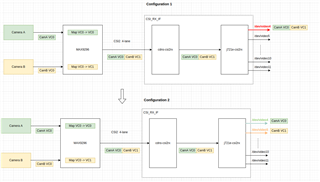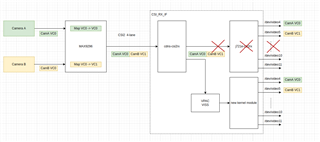Tool/software:
Hi expert,
I am currently bring up two Ommivision OX03A10 based cameras using MAX9296 deserializer chip binded to CSI-A port 0 on the J784S4-EVM board as shown in Configuration 1 in below figure.
I see the captured streams from both camera are multiplexing at the output V4L2 video node, i.e. /dev/video4 in configuration 1.

My question is to how to split the captured streams of the two cameras into two different video nodes? For example, camera A and camera B can be captured at /dev/video4 and /dev/video5, respectively, as shown configuration 2 in below figure:

Same question also applied to a single camera that sends multiple streams in multiple VC, how can we split output each stream to an independent video output node? Can it be done by CSI_RX_IF hardware?
Thanks,
Minh


